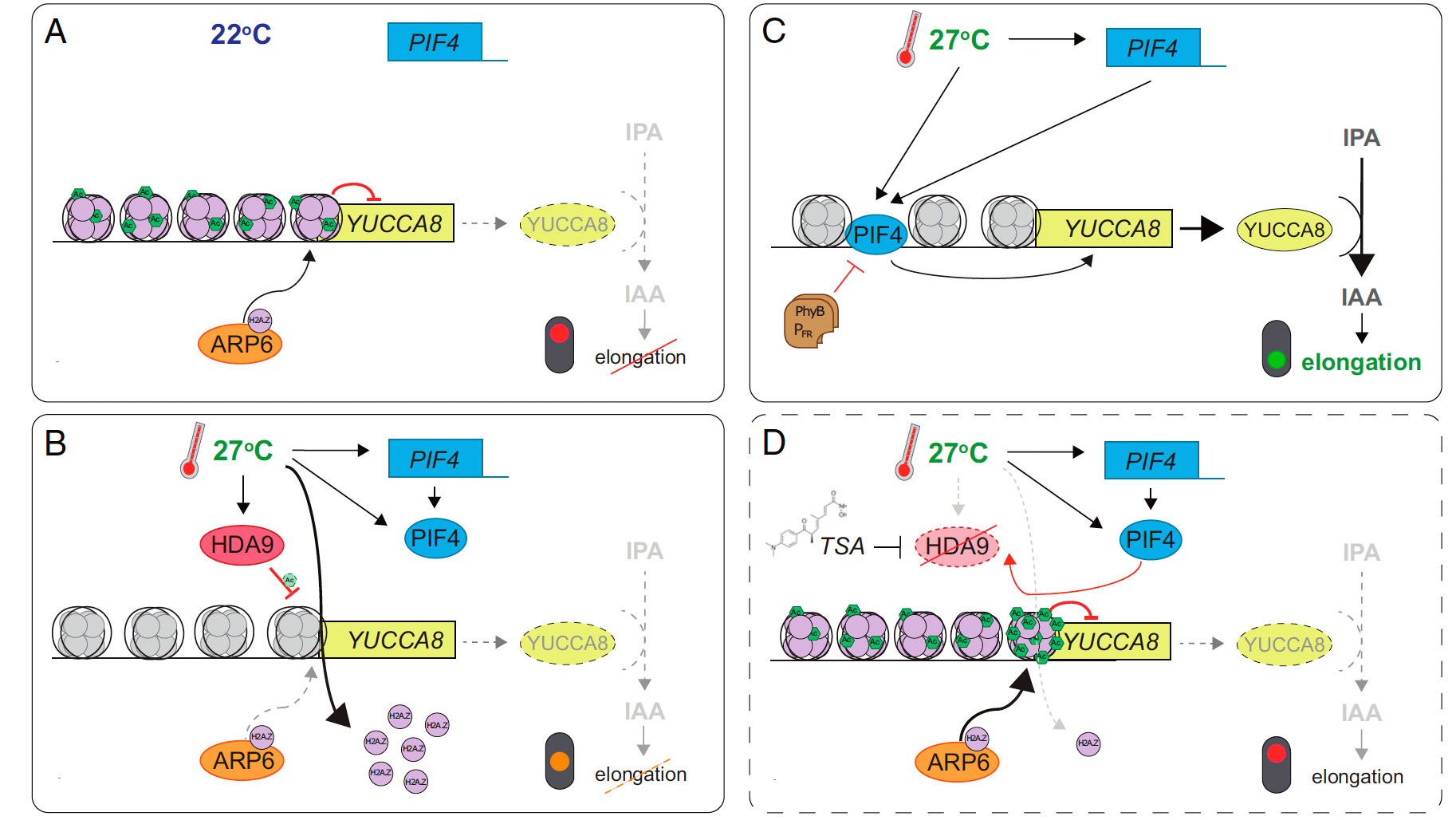博文
PNAS:拟南芥组蛋白去乙酰化酶HDA9介导生长素依赖性的热形态建成
||
HISTONE DEACETYLASE 9 stimulates auxin-dependent thermomorphogenesis in Arabidopsis thaliana by mediating H2A.Z depletion
First author: Lennard C. van der Woude; Affiliations: Utrecht University (乌特勒支大学): Utrecht, Netherlands
Corresponding author: Martijn van Zanten
Many plant species respond to unfavorable high ambient temperatures by adjusting their vegetative body plan to facilitate cooling. This process is known as thermomorphogenesis and is induced by the phytohormone auxin. Here, we demonstrate that the chromatin-modifying enzyme HISTONE DEACETYLASE 9 (HDA9) mediates thermomorphogenesis but does not interfere with hypocotyl elongation during shade avoidance. HDA9 is stabilized in response to high temperature and mediates histone deacetylation at the YUCCA8 locus, a rate-limiting enzyme in auxin biosynthesis, at warm temperatures. We show that HDA9 permits net eviction of the H2A.Z histone variant from nucleosomes associated with YUCCA8, allowing binding and transcriptional activation by PHYTOCHROME INTERACTING FACTOR 4, followed by auxin accumulation and thermomorphogenesis.

许多植物会通过调整其营养器官体轴来降低自身的温度,从而适应不适宜的高温环境。该过程叫做植物的热形态建成,是由植物激素生长素所诱导的。本文中,作者揭示了染色质修饰酶HDA9介导了植物的热形态建成,但并不影响避荫过程中下胚轴的伸长。HDA9蛋白在响应高温时比较稳定,在气温温暖时介导生长素合成途径中的一个限速酶YUCCA8位点的组蛋白去乙酰化。作者的研究显示HDA9会将H2A.Z组蛋白变体驱逐出YUCCA8相关的核小体,从而使得光敏色素互作因子PIF4能够顺利结合并激活YUCCA8基因的转录,从而促进下游的生长素积累和热形态建成。
通讯:Martijn van Zanten(https://www.uu.nl/en/research/molecular-plant-physiology/dr-martijn-van-zanten)
个人简介:2004-2009年,乌特勒支大学,博士;2009-2011年,马克斯·普朗克植物育种研究所,博士后。
研究方向:植物热形态建成背后潜在的分子遗传调控机制。
doi: https://doi.org/10.1073/pnas.1911694116
Journal: PNAS
First Published: November 25, 2019

https://blog.sciencenet.cn/blog-3158122-1207816.html
上一篇:Molecular Plant:薏米基因组
下一篇:eLife:植物NLR免疫受体蛋白N端功能保守性MADA基序作用于植物免疫
全部作者的其他最新博文
- • Plant Physiology:CsMADS3促进柑果中的叶绿素降解和类胡萝卜素合成(华中农业大学)
- • Molecular Plant:LBD11-ROS反馈调节作用于拟南芥的维管形成层增殖和次生生长(浦项科技大学)
- • Science Advances:根结线虫通过调控植物的CLE3-CLV1模块,促进侵染进程(日本熊本大学)
- • Nature Communications:油菜素内酯参与植物营养生长期转变的分子机制解析(浙江农林大学)
- • Current Biology:光合作用产生的蔗糖驱动侧根“生物钟”(德国弗莱堡大学)
- • PNAS:花同源异型基因在叶中被抑制、花中被激活的分子机制(南卡罗来纳大学)